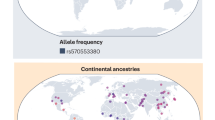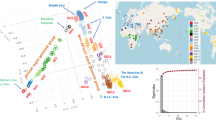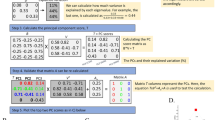Abstract
New genetic data has enabled scientists to re-examine the relationship between human genetic variation and 'race'. We review the results of genetic analyses that show that human genetic variation is geographically structured, in accord with historical patterns of gene flow and genetic drift. Analysis of many loci now yields reasonably accurate estimates of genetic similarity among individuals, rather than populations. Clustering of individuals is correlated with geographic origin or ancestry. These clusters are also correlated with some traditional concepts of race, but the correlations are imperfect because genetic variation tends to be distributed in a continuous, overlapping fashion among populations. Therefore, ancestry, or even race, may in some cases prove useful in the biomedical setting, but direct assessment of disease-related genetic variation will ultimately yield more accurate and beneficial information.
This is a preview of subscription content, access via your institution
Access options
Access to this article via ICE Institution of Civil Engineers is not available.
Subscribe to this journal
Receive 12 print issues and online access
$209.00 per year
only $17.42 per issue
Buy this article
- Purchase on SpringerLink
- Instant access to full article PDF
Prices may be subject to local taxes which are calculated during checkout




Similar content being viewed by others
References
Smedley, A. Race in North America: Origin and Evolution of a Worldview (Westview, Boulder, 1999).
Sankar, P. & Cho, M.K. Genetics. Toward a new vocabulary of human genetic variation. Science 298, 1337–1338 (2002).
Foster, M.W. & Sharp, R.R. Race, ethnicity, and genomics: social classifications as proxies of biological heterogeneity. Genome Res. 12, 844–850 (2002).
Schwartz, R.S. Racial profiling in medical research. N. Engl. J. Med. 344, 1392–1393 (2001).
Haga, S.B. & Venter, J.C. Genetics. FDA races in wrong direction. Science 301, 466 (2003).
Risch, N., Burchard, E., Ziv, E. & Tang, H. Categorization of humans in biomedical research: genes, race and disease. Genome Biol. 3, comment2007 (2002).
Burchard, E.G. et al. The importance of race and ethnic background in biomedical research and clinical practice. N. Engl. J. Med. 348, 1170–1175 (2003).
Wood, A.J. Racial differences in the response to drugs—pointers to genetic differences. N. Engl. J. Med. 344, 1394–1396 (2001).
Sachidanandam, R. et al. A map of human genome sequence variation containing 1.42 million single nucleotide polymorphisms. Nature 409, 928–933 (2001).
Schneider, J.A. et al. DNA variability of human genes. Mech. Ageing Dev 124, 17–25 (2003).
Fischer, A., Wiebe, V., Paabo, S. & Przeworski, M. Evidence for a complex demographic history of chimpanzees. Mol. Biol. Evol. 21, 799–808 (2004).
Li, W.-H. & Sadler, L.A. Low nucleotide diversity in man. Genetics 129, 513–523 (1991).
Harpending, H.C. et al. Genetic traces of ancient demography. Proc. Natl. Acad. Sci. USA 95, 1961–1967 (1998).
Sakate, R. et al. Analysis of 5′-end sequences of chimpanzee cDNAs. Genome Res. 13, 1022–1026 (2003).
Wildman, D.E. A map of the common chimpanzee genome. Bioessays 24, 490–493 (2002).
Nei, M. & Livshits, G. Genetic relationships of Europeans, Asians and Africans and the origin of modern Homo sapiens. Hum. Hered. 39, 276–281 (1989).
Cavalli-Sforza, L.L. & Bodmer, W.F. The Genetics of Human Populations, (W.H. Freeman, San Francisco, 1971).
Jorde, L.B. et al. The distribution of human genetic diversity: a comparison of mitochondrial, autosomal, and Y chromosome data. Am. J. Hum. Genet. 66, 979–988 (2000).
Barbujani, G., Magagni, A., Minch, E. & Cavalli-Sforza, L.L. An apportionment of human DNA diversity. Proc. Natl. Acad. Sci. USA 94, 4516–4519 (1997).
Lewontin, R.C. The apportionment of human diversity. Evol. Biol. 6, 381–398 (1972).
Watkins, W.S. et al. Genetic variation among world populations: inferences from 100 Alu insertion polymorphisms. Genome Res. 13, 1607–1618 (2003).
Yu, N. et al. Larger genetic differences within Africans than between Africans and Eurasians. Genetics 161, 269–274 (2002).
Tishkoff, S.A. & Verrelli, B.C. Patterns of Human Genetic Diversity: Implications for Human Evolutionary History and Disease. Annu. Rev. Genomics Hum. Genet. 4, 293–340 (2003).
Jorde, L.B., Watkins, W.S. & Bamshad, M.J. Population genomics: a bridge from evolutionary history to genetic medicine. Hum. Mol. Genet. 10, 2199–2207 (2001).
Underhill, P.A. et al. Y chromosome sequence variation and the history of human populations. Nat. Genet. 26, 358–361 (2000).
Ingman, M., Kaessmann, H., Pääbo, S. & Gyllensten, U. Mitochondrial genome variation and the origin of modern humans. Nature 408, 708–713 (2000).
Calafell, F., Shuster, A., Speed, W.C., Kidd, J.R. & Kidd, K.K. Short tandem repeat polymorphism evolution in humans. Eur. J. Hum. Genet. 6, 38–49 (1998).
Cavalli-Sforza, L.L., Menozzi, P. & Piazza, A. The History and Geography of Human Genes (Princeton University Press, Princeton, 1994).
Jorde, L.B., Bamshad, M. & Rogers, A.R. Using mitochondrial and nuclear DNA markers to reconstruct human evolution. Bioessays 20, 126–136 (1998).
Romualdi, C. et al. Patterns of human diversity, within and among continents, inferred from biallelic DNA polymorphisms. Genome Res. 12, 602–612 (2002).
Wilson, J.F. et al. Population genetic structure of variable drug response. Nat. Genet. 29, 265–269 (2001).
Bamshad, M.J. et al. Human population genetic structure and inference of group membership. Am. J. Hum. Genet. 72, 578–589 (2003).
Rosenberg, N.A. et al. Genetic structure of human populations. Science 298, 2381–2385 (2002).
Shriver, M.D. et al. The genomic distribution of population substructure in four populations using 8,525 autosomal SNPs. Hum. Genomics 1, 274–286 (2004).
Bowcock, A.M. et al. High resolution of human evolutionary trees with polymorphic microsatellites. Nature 368, 455–457 (1994).
Mountain, J.L. & Cavalli-Sforza, L.L. Multilocus genotypes, a tree of individuals, and human evolutionary history. Am. J. Hum. Genet. 61, 705–718 (1997).
Tishkoff, X. & Kidd, X. Title. Nat. Genet. 36 Supplement, ′–′ (2004). [this issue]
Pritchard, J.K., Stephens, M. & Donnelly, P. Inference of population structure using multilocus genotype data. Genetics 155, 945–959 (2000).
Edwards, A.W.F. Human genetic diversity: Lewontin's fallacy. Bioessays 25, 798–801 (2003).
Bamshad, M. et al. Genetic evidence on the origins of Indian caste populations. Genome Res. 11, 994–1104 (2001).
Feldman, M.W., Lewontin, R.C. & King, M.-C. A genetic melting-pot. Nature 424, 374 (2003).
Cavalli-Sforza, L.L., Menozzi, P. & Piazza, A. Demic expansions and human evolution. Science 259, 639–646 (1993).
Blumenbach, J.F. On the Natural Varieties of Mankind (De Generis Humani Varietate Nativa). Translated and edited by T. Bendyshe. (Bergman, New York, 1969).
Darwin, C. The Descent of Man, and Selection in Relation to Sex (John Murray, London, 1871).
Boyd, W.C. Genetics and the Races of Man: An Introduction to Physical Anthropology (Little Brown, Boston, 1950).
Exner, D.V., Dries, D.L., Domanski, M.J. & Cohn, J.N. Lesser response to angiotensin-converting-enzyme inhibitor therapy in black as compared with white patients with left ventricular dysfunction. N. Engl. J. Med. 344, 1351–1357 (2001).
Varner, R.V., Ruiz, P. & Small, D.R. Black and white patients response to antidepressant treatment for major depression. Psychiatr. Q. 69, 117–125 (1998).
Strickland, T.L., Stein, R., Lin, K.M., Risby, E. & Fong, R. The pharmacologic treatment of anxiety and depression in African Americans. Considerations for the general practitioner. Arch. Fam. Med. 6, 371–375 (1997).
Bamshad, M., Wooding, S., Salisbury, B.A. & Stephens, J.C. Deconstructing the relationship between genetics and race. Nat. Rev. Genet. 5, 598–609 (2004).
Evans, W.E. & Relling, M.V. Moving towards individualized medicine with pharmacogenomics. Nature 429, 464–468 (2004).
Patil, N. et al. Blocks of limited haplotype diversity revealed by high-resolution scanning of human chromosome 21. Science 294, 1719–1723 (2001).
Gabriel, S.B. et al. The structure of haplotype blocks in the human genome. Science 296, 2225–2229 (2002).
Kunz, R., Kreutz, R., Beige, J., Distler, A. & Sharma, A.M. Association between the angiotensinogen 235T-variant and essential hypertension in whites: a systematic review and methodological appraisal. Hypertension 30, 1331–1337 (1997).
Nakajima, T. et al. Natural selection and population history in the human angiotensinogen gene (AGT): 736 complete AGT sequences in chromosomes from around the world. Am. J. Hum. Genet. 74, 898–916 (2004).
Weinshilboum, R. Inheritance and drug response. N. Engl. J. Med. 348, 529–537 (2003).
Bradford, L.D. CYP2D6 allele frequency in European Caucasians, Asians, Africans and their descendants. Pharmacogenomics 3, 229–243 (2002).
Cooper, R.S., Kaufman, J.S. & Ward, R. Race and genomics. N. Engl. J. Med. 348, 1166–1170 (2003).
Sehgal, A.R. Overlap between whites and blacks in response to antihypertensive drugs. Hypertension 43, 566–572 (2004).
Roses, A.D. Pharmacogenetics and the practice of medicine. Nature 405, 857–865 (2000).
Cooper, R.S., Rotimi, C.N. & Ward, R. The puzzle of hypertension in African-Americans. Sci. Am. 280, 56–63 (1999).
Laitinen, T. et al. Characterization of a common susceptibility locus for asthma-related traits. Science 304, 300–304 (2004).
Altshuler, D. et al. The common PPARgamma Pro12Ala polymorphism is associated with decreased risk of type 2 diabetes. Nat. Genet. 26, 76–80 (2000).
Hugot, J.P. et al. Association of NOD2 leucine-rich repeat variants with susceptibility to Crohn's disease. Nature 411, 599–603 (2001).
Van Eerdewegh, P. et al. Association of the ADAM33 gene with asthma and bronchial hyperresponsiveness. Nature 418, 426–430 (2002).
Selkoe, D.J. & Podlisny, M.B. Deciphering the genetic basis of Alzheimer's disease. Annu. Rev. Genomics Hum. Genet. 3, 67–99 (2002).
Chung, C.H., Bernard, P.S. & Perou, C.M. Molecular portraits and the family tree of cancer. Nat. Genet. 32 Suppl, 533–540 (2002).
Gilad, Y., Rosenberg, S., Przeworski, M., Lancet, D. & Skorecki, K. Evidence for positive selection and population structure at the human MAO-A gene. Proc. Natl. Acad. Sci. USA 99, 862–867 (2002).
Ding, Y.C. et al. Evidence of positive selection acting at the human dopamine receptor D4 gene locus. Proc. Natl. Acad. Sci. USA 99, 309–314 (2002).
Harpending, H. & Cochran, G. In our genes. Proc. Natl. Acad. Sci. USA 99, 10–12 (2002).
Bouchard, T.J. Jr. & Loehlin, J.C. Genes, evolution, and personality. Behav. Genet. 31, 243–273 (2001).
Excoffier, L. & Hamilton, G. Comment on “Genetic structure of human populations”. Science 300, 1877 (2003).
Jorde, L.B. et al. Microsatellite diversity and the demographic history of modern humans. Proc. Natl. Acad. Sci. USA 94, 3100–3103 (1997).
Watkins, W.S. et al. Patterns of ancestral human diversity: an analysis of Alu insertion and restriction site polymorphisms. Am. J. Hum. Genet. 68, 738–752 (2001).
Felsenstein, J. PHYLIP (Phylogeny Inference Package) version 3.5c. (Department of Genetics, University of Washington, 1993).
Acknowledgements
We thank M. Bamshad, A. Rogers, S. Watkins and D. Witherspoon for comments on this manuscript. This work was supported by grants from the US National Institutes of Health and the US National Science Foundation.
Author information
Authors and Affiliations
Corresponding author
Ethics declarations
Competing interests
The authors declare no competing financial interests.
Rights and permissions
About this article
Cite this article
Jorde, L., Wooding, S. Genetic variation, classification and 'race'. Nat Genet 36 (Suppl 11), S28–S33 (2004). https://doi.org/10.1038/ng1435
Received:
Accepted:
Published:
Issue Date:
DOI: https://doi.org/10.1038/ng1435



